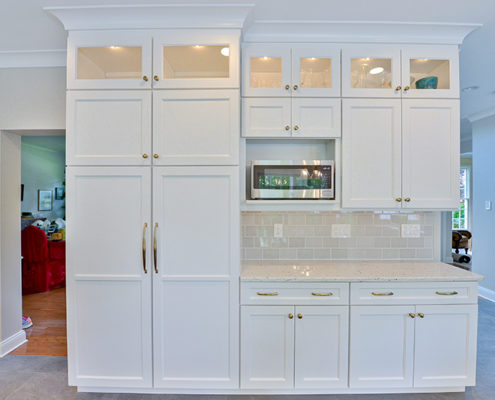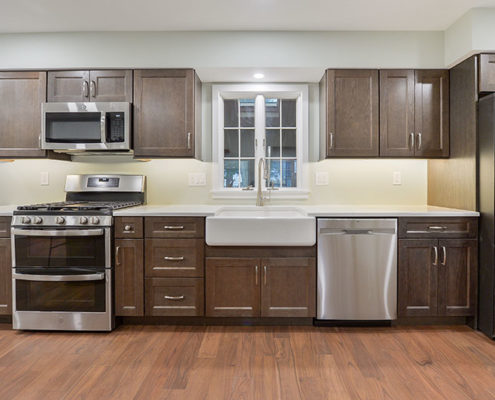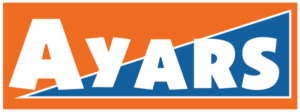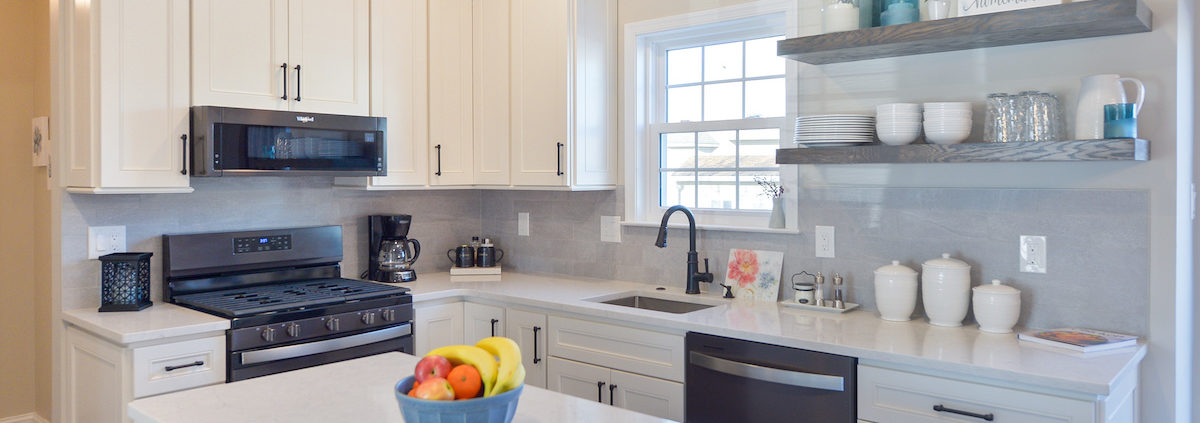A Guide to Kitchen Cabinet Options
Any kitchen remodeling consultation should begin with a discussion of your kitchen cabinet options. From floor to ceiling and wall to wall, no other element has quite the same visual impact. And if we’re talking about organization and productivity, nothing sets you up for success like kitchen cabinetry.
That’s why we prefer to take our time to go through kitchen cabinet styles, materials, finishes, and hardware — it’s the best path to realizing your kitchen’s full potential!
Types of Kitchen Cabinets
We can classify the types of kitchen cabinetry several ways.
Cabinet types by customization level
- Stock cabinets, aka ready-to-assemble (RTA) cabinets, are a good kitchen cabinet option for budget-minded homeowners with a bit of DIY know-how. Mass-manufactured and easily attainable from virtually any hardware store, they can be delivered and put together in short order.
- Semi-custom cabinets, although still mass-produced, allow for a lot more flexibility on your part. Design features and hardware can be mixed and matched to your liking (within limits), and they can be adjusted on-site during install to assure a better fit.
- Custom cabinets can be anything and everything you might imagine, but come at a cost, as they require the services of a skilled craftsman. The cabinetmaker will design and build cabinets to meet your exact specifications, as well as the unique dimensions of your kitchen. Fine-tuning can be expected along the way.
Cabinet types by installation location
- Base cabinets form the foundation for your kitchen countertop, resting on the ground. A toe kick covers the area between the bottom of the cabinet box and the floor.
- Wall cabinets, as their name suggests, are hung or mounted on the wall. Because they do not have to accommodate a countertop, they allow for more in the way of decorative flourishes, such as crown molding.
- Pantry cabinets will span all or most of the height of your kitchen and offer the most storage.
Cabinet types by material
Kitchen cabinets are constructed from natural wood, engineered wood products, or some combination thereof.
- Popular natural wood specimens include maple, cherry, hickory, and oak. Real wood is sturdy enough to hold up to abuse and the only candidate for staining.
- Engineered wood materials are produced by fusing or layering together wood fibers and other byproducts, sometimes blended with man-made plastic resins to achieve more desirable properties. Medium density fiberboard (MDF) and plywood are the most popular in the world of cabinetmaking, as they are relatively resilient and cost-effective without being “cheap” (e.g. particleboard).
Some materials serve better for certain cabinet components or applications than others. For instance, the smooth and non-porous qualities of MDF are ideal for painted cabinets, while plywood is great for areas where structural integrity trumps aesthetics (e.g. interior shelves, sidewalls). Meanwhile, you could still use natural hardwood for the cabinet doors, or something like cabinet veneers (thin slices of wood affixed to an MDF base) to achieve similar visual appeal without the heft.

Pantry cabinets and base cabinets rest on the floor, while wall cabinets are hung on the wall and are apt to include more decorative flourishes (such as the glass panels and crown molding seen here).
Styles of Kitchen Cabinets
Framed vs. frameless kitchen cabinets
Before we talk about cabinet doors — the defining feature of our kitchen cabinet styles — let’s talk about framing. Basically, cabinet doors are either hung on a frame or they aren’t.
- Framed cabinets include an outfacing frame attached to the cabinet box (i.e. the “bones” of the cabinet) to which the door and hinges are affixed. The door can either sit atop the frame (overlay cabinet doors) or nestle inside it (inset cabinet doors) when closed.
- Frameless cabinets forgo the frames entirely, with the doors hinged from the inside of the cabinet box itself. The resulting look tends to be more modern and minimalist, while offering maximum storage capacity. However, they’re trickier to install and tend to be pricier.
Cabinet door styles
There are three primary cabinet door styles:
- Recessed panel: center of panel set slightly inward compared to edges
- Raised panel: center of door panel protrudes slightly compared to edges
- Flat panel (aka slab): no dimensional variance from edge to edge; sleek and modern.
From there, we can customize the shape of the central panel element (if present):
- Shaker-style kitchen cabinet doors are a perennial favorite due to their simplicity and versatility. They feature a clean “rectangle inside a rectangle” look with the central panel framed by two rails (running horizontally) and two stiles ( running vertically).
- For a more traditional aesthetic, you might opt for arches or cathedral arches on your door panel. The cathedral arch adds additional flourish with the arch tapering to a pointed peak.
- If farmhouse or cottage-core is more your speed, beadboard cabinet doors could be ideal for you. Their distinctive panels are characterized by the vertical grooves (aka beading) spanning their width.
- Of course, you could also swap out the wood for a glass-fronted cabinet door to display your most prized dishware or family heirlooms.
Cabinet finishes
Perhaps the most important decision you’ll make regarding your kitchen cabinet options is the finish. Again, you could go one of three routes:
- Painted: The smoothest of cabinet finishes, with nearly infinite possibilities. The most timeless kitchen designs utilize some shade of white or off-white, but grays have their advocates, and blues and (especially) greens are in vogue right now.
- Stained: Only applicable to wood cabinets, stains (ranging from transparent to dark) are used to highlight the natural grain patterns and/or color of the underlying wood species to varying degrees. While wood cabinets can also be painted, stains tend to be a lot more forgiving over time. Trendy white oak kitchen cabinets are a particular favorite in 2023.
- Laminate: The most economical of cabinet finishes, these laminate veneers serve as a sort of “temporary tattoo” for more budget-friendly cabinet doors made of MDF or particleboard. While they might convincingly mimic the look of stained cabinets, temperature and humidity changes within the kitchen can cause them to peel away over time.

Wood stains range from transparent to the darker tones seen here and are a great way to highlight the natural beauty of the material.
Cabinet hardware
When we refer to cabinet hardware, we are talking about the mechanical components that make them function. Internally, we probably only care that our hinges (doors) and sliders (drawers) function properly. Externally, however, cabinet hardware is the “jewelry” that completes your kitchen’s outfit. Oh, and helps you open and close your cabinets too.
- Knobs are best for cabinet doors or smaller drawers. They range in shape from round to square to rectangular to novelty.
- Pulls are great for tall pantry doors or longer cabinet drawers. They can either be affixed to the front (drop handle) or built into the bottom or side (recessed) — common with slab doors.
Beyond the shape and installation, we can further customize cabinet hardware by determining our finish metal (eg. zinc, copper, or brass) and its luster (i.e. level of shininess).
Cabinet moldings
A hallmark of luxury and high end kitchen cabinetry, decorative molding (aka millwork) employs the carpenter’s craft to the fullest, using various cuts and angles to add dimension and elegance — for example, crown molding applied between the tops of wall cabinets and the ceiling.
Get Inspired with Ayars
As you can see, your kitchen cabinet options are truly limitless, especially once you delve into the worlds of semi-custom or custom kitchen cabinetry. If you’re looking for inspiration, a good place to start is our project portfolio galleries. Whether you’re a good fit for Ayars’ services, partner with a cabinetmaker in your area, or have the know-how or courage to DIY, we hope you find a look you love for a lifetime.




